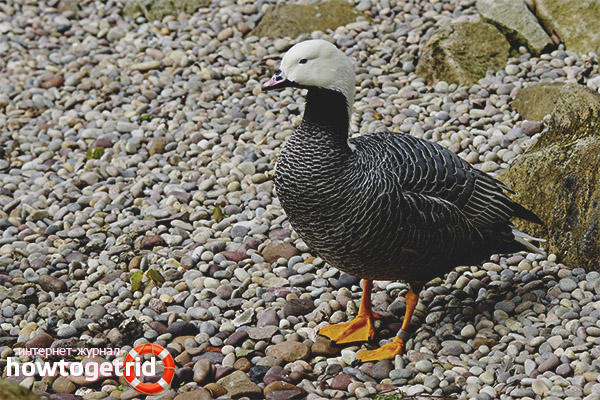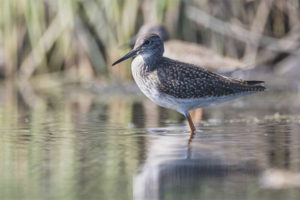The content of the article
The bird is slightly inferior in size to its home relative, and she exchanged a warm house for endless expanses of the tundra. Its number is steadily declining under the pressure of external changes, as the habitat is changing. Severe living conditions provoke high mortality of young growth, but geese stubbornly return every year to the coast of the Bering Sea, the cold waves of which they saw hatching from an egg.
Northern handsome
The main difference between a goose - a whitewashed from other relatives was its color. He seemed to be dressed in chain mail from small motley links and only his head and neck remained white. A blue tone with a gray tint creates an amazing contrast with a brown breast and a white head. Elegant plumage is not striking, but performs a protective function. The bird is hard to see among the coastal stones and even harder to see on the glinting sea waves. The weight of an adult varies between 2.5 kg, a distinctive feature of the species is a short thick neck. There is no particular difference between the color of the male and the female.
Geese inhabit Chukotka, Alaska. Several colonies settled on the islands of St. Lawrence. Such a limited habitat has become one of the reasons for the gradual decline in the population of the species. In winter, birds fly to the Kuril, Aleutian and Commander Islands.
The geese menu includes plant foods, they eat leaves, branches, roots, inflorescences. Willingly feast on mussels and crustaceans. To extract food, they lower their heads into the water and carefully look out for delicacies. Sometimes ornithologists observe an interesting picture when a goose with its beak and paws forms a hole in shallow water and catches from it mollusks that have fallen.
Family matters
Couples are created for life or until the death of one of the partners. The female is engaged in the selection of the place and the construction of the nest. The male is assigned the role of guard and defender of the territory. He aggressively reacts to any creature that dares to violate the borders of the territory, spreads its wings, hisses menacingly and steps on the enemy. For nesting and molting, they absorb low-grass tundra, coasts of bays, lagoons and the sea coastal zone.
In the nest there are from 3 to 8 eggs, most often clutches with 5 eggs are found. The female incubates the chicks for 24 to 25 days, allowing herself to stretch her legs for only a few minutes, practically without departing from the nest. By the time goslings appear, she is losing a fifth of her weight. The chicks mature for a long time, so those who appeared early will get stronger and better survive the winter. Up to a month, sometimes longer, goslings are covered with thick grayish fluff; they fully rely on the 47th day of life. But they begin to fly early, about 2 months after birth.
For a long time the family does not stay in the nest, preferring to move closer to the marshy shallows of the coastal zone for 10 days already, there the food is bigger and safer. Geese fleeing enemies on the water. Foxes, owls, eagles, golden eagles, arctic foxes, minks cannot reach there.
The first winter, the chicks do not depart far from their parents and together return to their nesting sites. Here their paths diverge, since an adult female begins to lay eggs only at 3-4 years of age, and the formed pair will not tolerate anyone, even older children, on its territory during the breeding season.
Despite the fact that the bird carefully guards the nest, often eggs of other species or an adjacent pair of geese are thrown into it. The female picks him up and incubates with her.
Interesting Facts

White geese do not hide from observers and calmly treat strangers until they encroach on their territory.Therefore, it is known about them that:
- A distinctive feature - only adult birds have a white neck and head.
- Adults are very silent, it is difficult to hear their voice.
- Birds of this species have taken root well in captivity and are bred as domestic.
- In 1998, as part of the Red Book series, a coin was issued, on which an image of a goose - a whitish bearer was placed.
The white goose is listed in the Red Book, in nature its number is gradually declining. This handsome man is under the protection of the law and there is hope that the view will be preserved.
Video: White Goose (Anser canagicus)










Submit